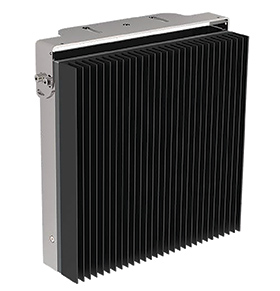

Infrared thermometers are calibrated with the help of reference radiation sources, so-called ‘black bodies’. These radiant sources are able to produce different temperatures with a high stability.
Knowing the exact value of the radiation temperature is essential for the calibration process. It can be measured by either using a contact thermometer (in combination with the determination of the emissivity) or a transfer standard infrared (IR) thermometer. This value can then be used to determine the device constant for an initial calibration of the infrared sensors. In order to conduct a post-calibration by customers or local calibration facilities, the calibration temperature should be near the temperatures which occur at the respective applications.
Instrotech, local supplier of Optris products, makes use of a transfer standard radiation thermometer CTlaser-PTB to measure the radiation temperature of a reference source. The CTlaser- PTB is based on the IR thermometer Optris CTlaser. The CTlaser-PTB needs to be traceable to the international temperature scale from 1990 (ITS-90). Thus, it is calibrated by the PTB (German national metrology institute) on a regular basis.
ITS-90 is a very good approximation of thermodynamic temperature. It is based on 17 well-reproducible fixed values such as melting points of highly pure metals. Within the framework of ITS-90, the CTlaser-PTB is compared to national temperature standards from the PTB. This comparison within a closed chain of comparative measurements with a known uncertainty in measurement takes place on a regular basis.
Based on the CTlaser-PTB, Optris produces the CTlaser- DCI as a high-precision reference IR thermometer for its customers. The DCI units are produced with pre-selected components supporting a high stability of measurement. In combination with a dedicated calibration at several calibration points, the CTlaser-DCI achieves a higher accuracy than units from series production.
The optics of an IR thermometer are described by the distance-to-spot-ratio (D:S). Depending on the quality of the optics, a certain amount of radiation is also received from sources outside the specified measurement spot. The maximum value here equals the radiation emitted by a hemispheric radiant source. The respective signal change in correlation with a resize of the radiation source is described by the size-of-source effect (SSE).
As a result of this correlation, all manufacturers of IR thermometers use accurately defined geometries for the calibration of their units; meaning depending on the aperture of the radiation source (A), a distance (a) between the IR thermometer and the reference source is defined. Thus, the value specified in datasheets and technical documentation as a measurement field is in general a certain defined percentage of this radiation maximum – values of 90% or 95% are common.
Optris has up-to-date, in-house laboratories which fulfil the mandatory requirements for calibration stations. When issuing calibration certificates, it is not only the laboratory temperature and humidity that are documented but also the measurement distance and source diameter (calibration geometry).
Features of the BR400 calibration source are:
• Radiator temperature up to 400°C.
• Excellent homogeneity, precision and long-term stability.
• Compact and rugged design.
• Perfect for calibrating and testing infrared sensors.
• Scope of supply: calibration source, power supply cable, calibration certificate, manual.
To improve the specified camera accuracy of the PI 450i T010 camera, a reference source with a high emissivity and a stable and known temperature must be positioned in the scene proximate to the subject to be scanned. The BR 20AR ambient referencing source is equipped with a temperature probe with ±0,1°C accuracy.
By integrating this highly accurate reference signal to the PIX Connect software, Optris can reduce camera uncertainties resulting from device adjustment, ambient temperature drift and short-term stability down to a system accuracy of ±0,5°C.
BR20AR features include:
• Reference radiator with high emissivity ideal for IR camera-based fever screening applications.
• Integrated 16-bit digital temperature sensor with 0,1°C accuracy.
• Mounting bracket – adjustable for either ceiling or wall mounting.
• Plug-and-play installation with 20 m cable and PI 450i suitable PIF connector.
| Tel: | +27 10 595 1831 |
| Email: | [email protected] |
| www: | www.instrotech.co.za |
| Articles: | More information and articles about Instrotech |

© Technews Publishing (Pty) Ltd | All Rights Reserved